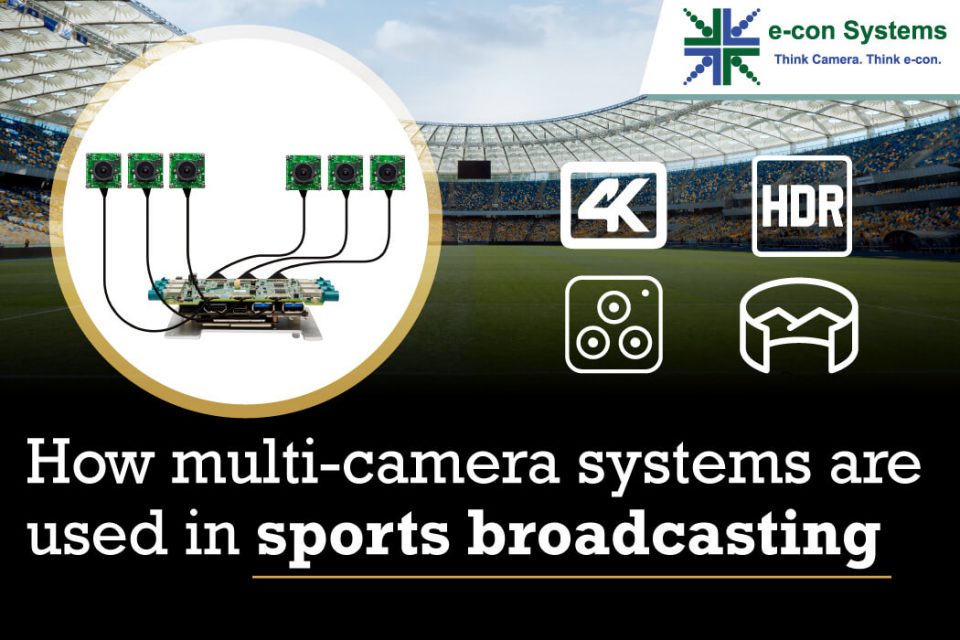Multi-camera systems are an integral force in sports broadcasting as they deliver comprehensive coverage, capturing the excitement and crucial moments of the game from multiple viewpoints. They also allow viewers, players, and coaches to analyze key moments from various angles and enable broadcasters to seamlessly switch between shots.
In this blog, you’ll get a wealth of insights on how multi-camera systems work, their biggest advantages, and the critical factors to consider when selecting the right multi-camera setup.
How do multi-camera systems work in sports broadcasting?
Automated sports broadcasting refers to the live streaming and telecasting of sports matches without the need for field operators or crew. Instead, it relies on embedded cameras strategically placed on the field. These cameras autonomously capture the action and send the feed directly to TV networks or streaming platforms for real-time broadcasting to audiences. Frame-level synchronization ensures seamless switching, while techniques like image stitching and graphics overlay enhance the viewing experience by providing wider angles and detailed analysis.
Some of the advantages are capturing various perspectives simultaneously, seamlessly transitioning between camera feeds, offering replays/slow-motion footage, etc.
What to consider while choosing a multi-camera system for sports broadcasting?
Indoor vs. outdoor environments
The lighting conditions can vary throughout the day in outdoor sports, such as football, soccer, or athletics. From bright sunlight to shadows cast by clouds or stadium structures, the dynamic lighting range can be extensive. So, it is recommended to use a camera that incorporates a High Dynamic Range (HDR) feature.
HDR technology enables cameras to capture a wider range of brightness levels, from the darkest shadows to the brightest highlights. It ensures no details are lost in areas with extreme contrast, providing more balanced images. Outdoor sports broadcasting also requires rugged and weather-resistant cameras, considering the likely exposure to harsh conditions like rain, wind, etc.
On the other hand, indoor arenas usually have controlled lighting conditions with consistent brightness levels. But the fast-paced nature of indoor sports often involves quick movements, low-light conditions, and the need to capture fast-action sequences.
High-speed cameras allow broadcasters to capture fast-paced action with minimal motion blur, ensuring every detail is crystal clear, even in the most dynamic moments. Also, cameras with excellent low-light performance can handle the challenges of indoor venues, where the lighting may not be as bright as in outdoor stadiums.
Resolution and video quality
The resolution determines the level of detail and clarity captured in the footage. Higher resolutions, such as 4K, offer greater detail, enabling viewers to see intricate aspects of the game, from facial expressions to subtle movements and ball trajectories.
But higher resolution cameras also come with higher data requirements. The network infrastructure should be capable of handling the increased bandwidth demands of high-resolution video streams to avoid buffering or quality degradation.
Video quality and resolution are also essential for implementing AI/ML algorithms. These algorithms rely on high-quality, high-resolution video feeds to derive actionable insights and perform advanced tasks like ball tracking, player tracking, etc.
The greater the level of detail and resolution captured by the cameras, the more accurate and reliable the AI/ML analysis can be. For instance, ball tracking algorithms require clear and detailed images to accurately track the ball’s movement throughout the game.
Field of View
When setting up a multi-camera system for sports broadcasting, the field of view is crucial to capture the action accurately without any unwanted lens distortions. While achieving a 180-degree field of view using a single camera is possible, there are certain drawbacks, such as lens distortions like fish-eye effects.
When the lens field of view exceeds the size of the camera’s sensor, the captured image may appear distorted or stretched, affecting the visual quality. Hence, a multi-camera system with 2 to 3 cameras is preferred to cover a wide field of view. By distributing the coverage among three cameras, each can have a field of view of approximately 70 degrees. This ensures that the combined field of view covers the desired 180 degrees.
Alongside the field of view, the frame rate is another vital aspect. A frame rate of 30 frames per second (fps) is sufficient for most cases, especially with 4K resolution. This frame rate ensures smooth motion capture and playback, enabling viewers to follow the fast-paced action without any perceptible lag or blur.
Number of cameras
The number of cameras directly impacts the coverage and depth of the live broadcast – enhancing the viewing experience for audiences. In a multi-camera setup, having an adequate number of cameras strategically placed across the sports venue allows for capturing various angles of the action. This enables the broadcaster to switch between shots and deliver dynamic viewing experiences. A higher number of cameras ensure that no crucial moments or plays are missed, allowing all the excitement and emotions of the game to be captured. Also, different camera angles can provide valuable insights to referees, coaches, and players for post-match analysis.
It is important to note that the Field of View and the resolution requirements determine the number of cameras to be used.
Camera interface
The camera interface and host platform ensure seamless data transfer and processing. For example, the MIPI interface emerges as the best choice given the requirements of transferring data from three cameras, each capturing 4K footage at 30 frames per second (fps). It enables fast and reliable communication between cameras and host platforms, facilitating the transfer of high-resolution video streams without compromising quality or latency.
But, the host platform must also be capable of handling the high throughput generated by the multi-camera system. For this level of performance, high-end processors like the NVIDIA Jetson AGX Xavier or AGX Orin are recommended for their computational power and advanced capabilities.
e-con Systems’ unique solution: 180-degree stitching on the edge
In the context of 180-degree stitching on the edge, e-con Systems’ unique solution ensures the synchronized frames from the three cameras are received at the MIPI receiver in the processing platform. Through the MIPI and camera drivers, the camera frames are accessed by the GPU. The GPU utilizes a pre-calibrated image stitching vector to stitch the frames from the three camera sources together, producing a single cohesive frame. This stitched image is then compressed and streamed to the cloud in the H.264 format for further analysis, including ball tracking, image cropping, player performance analysis, and more.
Achieving precise frame-level synchronization is crucial, but it necessitates a hardware-level approach so that the captured frames from each camera align perfectly. The synchronized frames enable accurate and seamless stitching, resulting in a cohesive 180-degree field of view.
Multi-camera systems offered by e-con Systems for sports broadcasting
e-con Systems has partnered with many clients to implement cutting-edge multi-camera systems for sports broadcasting. Our standout feature is our proprietary stitching algorithm, which seamlessly merges images from multiple cameras, resulting in a seamless 180-degree field of view. This stitching process is vital in delivering memorable viewer experiences.
Please explore our Camera Selector to see our end-to-end camera portfolio. If you need help integrating a multi-camera system into your sports broadcasting system, write to us at camerasolutions@e-consystems.com.

Ranjith is a camera solution architect with over 16 years of experience in embedded product development, electronics design, and product solutioning. In e-con Systems, he has been responsible for building 100+ vision solutions for customers spanning multiple areas within retail including self service kiosks, access control systems, smart checkouts and carts, retail monitoring systems, and much more.




